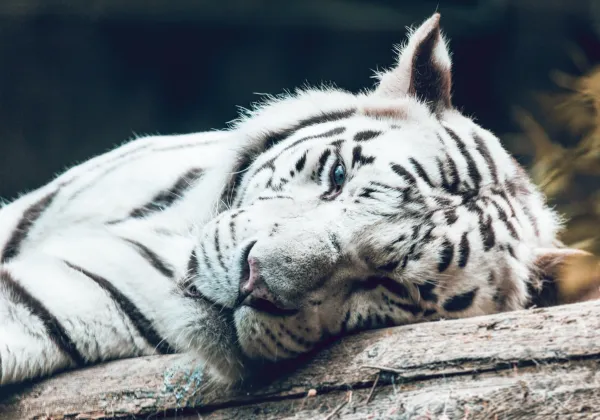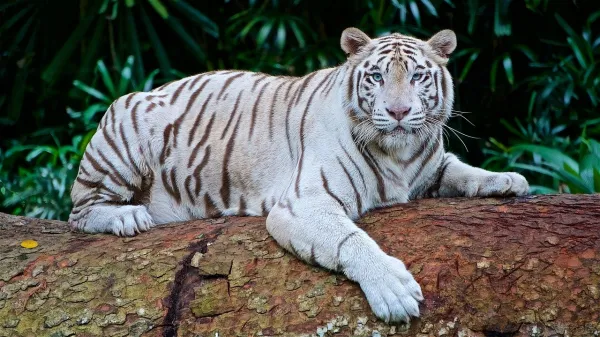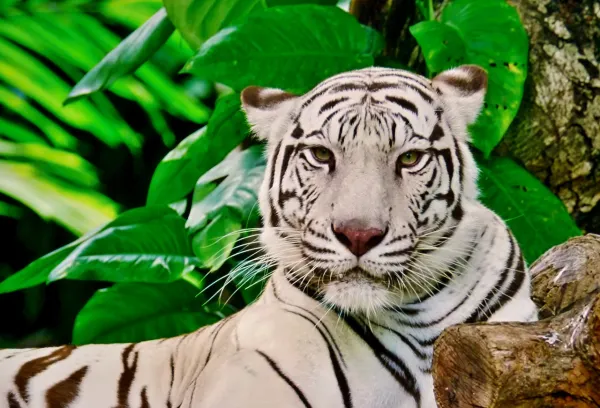The striking white coat and blue eyes of white tigers have made them star attractions in zoos and exotic animal shows around the world. But fame often hides uncomfortable facts: what exactly is a “white tiger,” why are there so many in captivity, and does breeding more white tigers help conservation at all? This guide explains the genetics and traits of white tigers, their true conservation status, the pressures threatening wild tigers, and what actually works to protect them.

(Panthera tigris · white color morph)
What a white tiger is (and isn’t): origin & key traits
Are white tigers endangered? How status is assessed
Main threats to wild white tigers (and all tigers)
Captive white tigers: potential benefits vs. serious costs
How to help white tigers—effective actions
Key takeaways
FAQs
Not a separate subspecies. A “white tiger” is a rare color morph that occasionally appears in Bengal tigers (P. t. tigris) and/or Siberian/Amur tigers (P. t. altaica).
Genetics. The pale coat results from two recessive alleles at a coat-color locus that suppress the usual orange pigment while leaving dark stripes.
Typical appearance. Cream-white fur with black/gray/light-brown stripes, usually blue eyes and a pink nose.
Fertility. White tigers are fully fertile and can breed with normally colored tigers of the same subspecies. Offspring are typically orange but carry the recessive allele; pairing two carriers can produce white cubs.
Body size. Many captive white tigers are reported to be heavier at birth and as adults—a pattern influenced by genetics, selection in captivity, and rich diets.
Ecology. White tigers have occurred naturally in the wild, but the color can make them more conspicuous. Today, most white tigers live in captivity, managed for display rather than reintroduction.

There are only a few hundred white tigers worldwide (rough order of magnitude), largely in captivity.
The IUCN Red List does not list “white tiger” separately; conservation status is evaluated for the parent subspecies.
Both Bengal and Amur tigers are listed as threatened/endangered, due to poaching, habitat loss, and prey declines. Protecting those wild subspecies is the meaningful way to protect the white color morph as well.
Poaching & illegal trade
Tigers are killed for skins, bones, and other body parts feeding black-market demand.
Habitat loss & fragmentation
Expanding agriculture, roads, and settlements shrink and fracture forests/grasslands, block movement corridors, and reduce breeding success.
Prey depletion
Overhunting and habitat change reduce populations of natural prey (deer, wild boar, etc.), pushing tigers toward conflict with people and livestock.
Potential short-term benefits
Keep the rare phenotype visible for education and fundraising—but only if programs are science-driven and ethical.
Major problems
Inbreeding risk. To “keep them white,” breeding programs have often relied on assortative mating and close relatives, which can increase congenital issues (hearing/vision defects, skeletal and immune problems) and reduce genetic diversity.
Welfare concerns. Performance-based shows, small enclosures, and poor enrichment cause chronic stress and abnormal behaviors.
Conservation distraction. Focusing on a cosmetic trait can divert funds and attention from protecting wild tiger habitats and populations.
Low reintroduction feasibility. Most captive white tigers lack wild skills, and suitable, secure release sites are scarce.
Bottom line: The best way to “save white tigers” is not to mass-breed them for display. It is to recover wild tiger populations and habitats so that natural genetic diversity—including rare color morphs—can persist without inbreeding.
Crack down on poaching and trade. Support frontline patrols, intelligence sharing, and strong prosecutions.
Protect and reconnect habitats. Expand protected areas, restore corridors, and mitigate road/rail barriers.
Rebuild prey bases. Enforce hunting limits and partner with local communities so wild prey populations recover.
Support institutions with independent welfare oversight, robust enrichment, and transparent conservation outcomes.
Avoid facilities that inbreed for color, promote close-contact photos, or stage performances.
Encourage zoos to channel resources into habitat protection, anti-poaching, and science, not cosmetic traits.
Refuse tiger products of any kind.
Donate or volunteer with reputable tiger conservation programs.
Choose no-contact, observation-based tourism that prioritizes animal welfare and real conservation.

White tigers are a color morph, not a separate subspecies; their future depends on the health of wild Bengal and Amur tiger populations.
Root causes of decline: poaching, habitat loss/fragmentation, and prey depletion.
Captive breeding for color carries inbreeding and welfare risks and rarely advances reintroduction.
The most effective path is habitat protection + anti-poaching + prey recovery + conflict reduction.
Do white tigers survive in the wild at all?
Historically, yes—white cubs have occasionally been born and survived in nature. The color can increase visibility, but survival hinges more on poaching pressure, habitat quality, and prey.
If they’re rare, why not breed many more white tigers?
Because that usually requires inbreeding, which harms health and doesn’t help wild recovery. Conservation should prioritize wild tigers and habitats.
Is a white tiger the same as an albino?
No. Most white tigers retain dark stripes and have blue (not red) eyes; this is a specific pigment pathway mutation, distinct from complete albinism.
Can zoo-born white tigers be released?
Generally not feasible. They lack wild skills and suitable release sites are limited. Money is far better spent on corridors, enforcement, and community programs in range countries.
Bibliography
EFE Editorial: Verde (06/26/2019) Two white tiger cubs, an endangered species, are born in Sendaviva Park (Navarra). EFE Agency: Verde - White tiger.
EFE Editorial: Verde (07/21/2014) Cabárceno welcomes two white tigers. EFE Agency: Verde - Nature, animals.
animal tags: white tiger
We created this article in conjunction with AI technology, then made sure it was fact-checked and edited by a Animals Top editor.